#QuantumProcessor8K
Text
Samsung Q950TS 8K Review
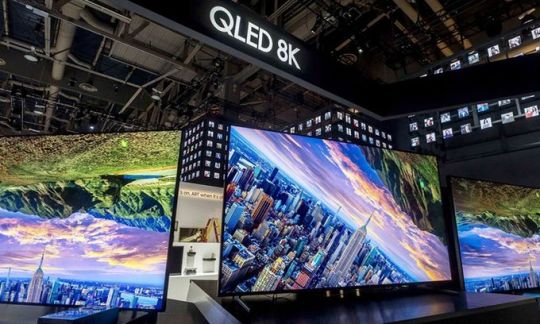
As known, these days companies present their new products at CES 2020. As usual, the attention of experts is primarily attracted by the leaders of the consumer electronics segment, which shape development trends. Of course, Samsung is one of them. The company fully met expectations by presenting three new TVs, including the second generation of Samsung 8K model, innovative MicroLED panels and the experimental The Sero TV with a rotary screen for viewing video content in vertical format, for example, from Instagram.
Of course, Samsung Q950TS aroused the greatest interest among experts. In fact, the company created the second generation of its 8K TV.
Today this model is one of the brightest among modern TVs. Its peak brightness reaches 4000 nits. The Q950TS uses a FALD (full array local dimming) with about 500 dimming zones. TV analyses a map of current image, defining bright or dark areas.
Samsung engineers demonstrated German pedantry, harmoniously improving almost all components, including design, processor, video processing algorithms, sound, modes and functions, etc.
Design
The company has taken the next step in implementing the bezel-less design concept, which it calls Infinity Design TV.
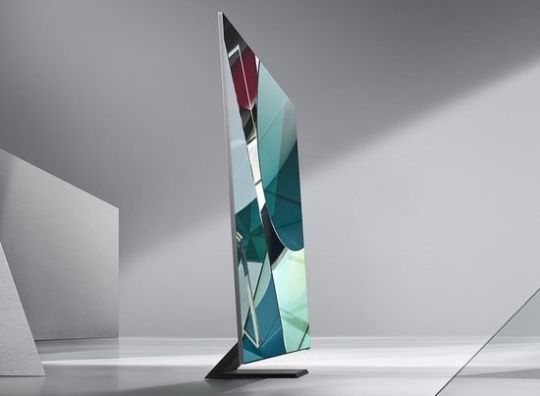
This TV has just a tiny 2mm-wide border around the top and side edgesand slightly wider border at the bottom with Samsung logo. As a result, engineers achieved an excellent result by providing a screen-to-body ratio of nearly 99%.
In addition, the bezel-less design creates a stunning effect of presence by lowering the visualization of the border between the screen and its surroundings. But it is maximally perceived when watching from 10-15 ft.
The 15 mm panel thickness is perfectly suitable for wall mounting, with the No Gap bracket. In this case, the screen can be connected with a single fiber cable.

A few years ago, Philips Electronics developed and patented Ambient Lighting technology.
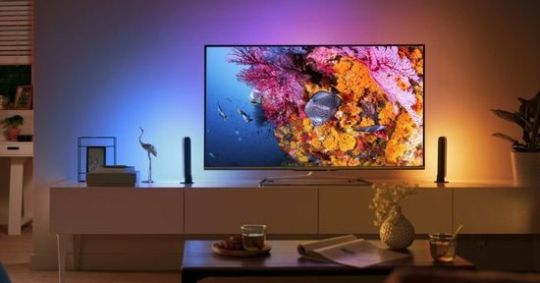
The idea was liked by many consumers and quickly became popular. In 2018, Samsung proposed their own idea by creating Ambient Mode.
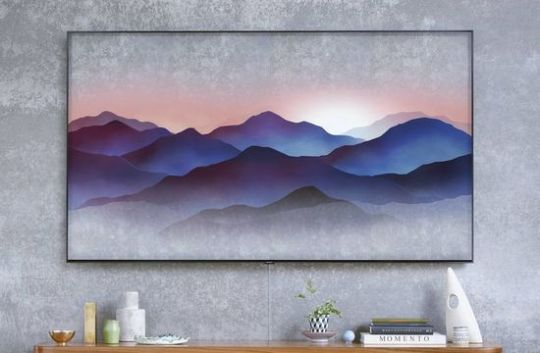
When the TV is off, Ambient Mode displays a stylish screensaver or family photo. In 2019, Samsung significantly improved it, expanding the range with images from the Internet. In addition, the company added new color filters, settings for background tones and brightness, animation, etc. This year, the company improved it with Bixby, Samsung’s AI assistant. For example, a TV can create a relaxing background on the screen by voice command. In fact, the TV performs in this mode the function of an intelligent element of the interior.
To date, Samsung has announced the 65-inch, 75-inch and 85-inch versions.
Sound system
Of course, the perception of media content is significantly dependent on sound quality. Therefore, the company made very great efforts, seriously improving the sound system.
Despite the ultra-thin design, South Korean engineers were able to place eight drivers in a six speaker array in the case. In fact, the Q950TS uses a 4.2.2-channel layout, which includes two speakers on each side, and a pair woofers in the back. The speakers are hidden behind a pattern of tiny holes in the outer edge of the TV body.
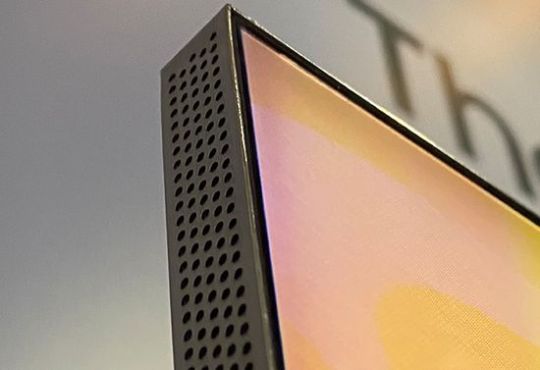
Mounted on a stand, the TV provides crisp and clear 5.1 channel surround. Unfortunately, the effectiveness of woofers with wall-mounting raises questions.
The Q950TS has a sound optimization feature for first setup. In this mode, the TV generates and sends out test tones, receives reflected signals using built-in microphones and measures them. Then, it creates a room map to create an optimal soundstage.
Unfortunately, the Q950TS does not support Dolby Atmos, but can send Atmos via ARC (audio return channel) from its internal apps.
Game mode
Almost all Samsung TVs of recent years are perfectly adapted for games. Q950TS was no exception.
Of course, the Q950TS supports VRR (variable refresh rate) and ALLM (Auto Low Latency Mode). In addition, the new TV also supports AMD FreeSync, which provides, for example, DisplayPort Adaptive-Sync. Today it is an ideal solution for smooth gameplay with decreased lag and virtually no tearing.
Moreover, the company claims no more than 10 ms input lag in Auto Game Samsung mode.
The Multi-View option is also convenient for side-by-side viewing the game videos.
In addition, the TV has a new surround mode with additional settings for sound effects in games. Also, Samsung has enhanced the Game Motion Plus feature. According to the company, the smooth playback in games has increased by 40%.
Q950TS features
1. Quantum Processor 8K provides more efficient AI upscaling, using machine learning algorithms to process data for each pixel. In addition, it generates image elements when restoring the original 8K content.
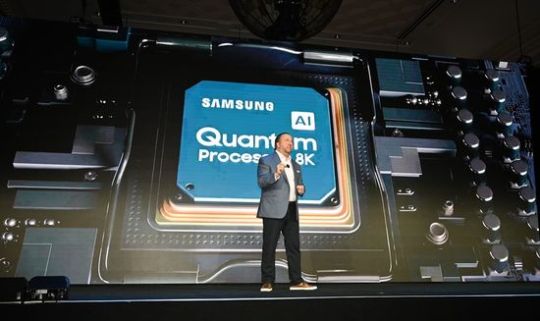
2. The new Adaptive Picture function automatically adjusts brightness and contrast depending on the ambient light.
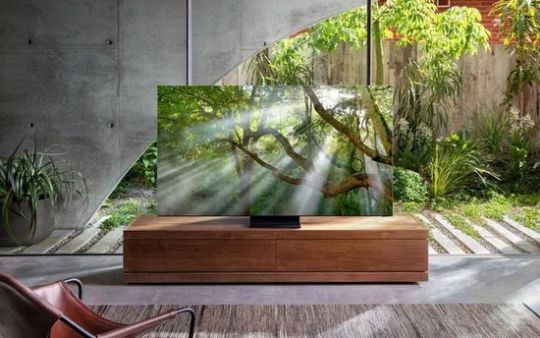
3. AI ScaleNet technology reduces data loss during video streaming. AI ScaleNet compresses the content during transmission from the provider, and then restores it to the TV. Thereby, the new technology halves the bandwidth requirements. According to Samsung, it will continue to actively improve this technology, considering it very promising. In particular, the company has agreed with Amazon Prime Video to jointly test the AI ScaleNet.
4. TV uses eight drivers, providing a 4.2.2-channel layout and OTS+ (Object Tracking Sound Plus) technology by analogy with Dolby Atmos and DTS: X. Their combination provides a stunning dynamic soundscape.
5.Active Voice Amplifier (AVA) adjusts the volume of dialogs depending on the noise level. For example, the noise of a blender or a vacuum cleaner automatically activates the option. But AVA activation during a loud conversation requires pressing a passive-aggressive button on the remote control.
6. Improved Universal Guide offers channels, content and services using AI-based algorithms.
7. Probably, Samsung Health with functions of a fitness organizer will appeal to supporters of a healthy lifestyle. In addition, it offers free and exclusive content from Calm, Echelon, FitPlan, Obe Fitness, Jillian Michaels, Barre 3, etc.
8. Multi-View projects the phone screen onto the TV screen in a separate window. The option has 14 different presets, including side-by-side viewing, picture-in-picture viewin, etc.
9. Digital Butler provides control of all IoT devices in the house using an infrared beam.
Conclusion
PROS
- bezel-less Infinity Design;
- high-quality 8K AI upscaling with AI Quantum Processor 8K;
- impressive picture quality;
- superior sonic performance with eight drivers (4.2.2-channel driver array);
- incredibly low input lag up to 10 ms in Auto Game Samsung mode;
- HDR support, including HDR10, HLG and HDR10+;
- Deep Learning with neural network;
- Ultra Viewing Angle;
- Adaptive Picture, Adaptive Peak Brightness and Adaptive Tone Mapping;
- Object Tracking Sound Plus (OTS+), Active Voice Amplifier and Q-Symphony;
- AV1 (AOMedia Video 1) codec for 8K YouTube.
CONS
- today OTS+ is inferior to Atmos;
- no Dolby Vision or Atmos support.
Traditionally, Samsung has proven its claim to leadership by introducing the Q950TS with a wealth of innovative solutions. The Bezel-less Infinity Design concept is already close to ideal. Screen-to-body ratio has already reached nearly 99%. Eight drivers in a 15 mm case are amazing. Moreover, the company has demonstrated its successes in fundamental areas, including the development of 8K AI upscaling based on Deep Learning using a neural network and AI ScaleNet. Of course, the Q950TS is unlikely to become BestSeller due to the high price, but the flagships do not pursue this goal. First of all, they must confirm the leadership ambitions of the company. Apparently, the Samsung Q950TS 8K perfectly coped with this task. This model embodied almost all the latest Samsung's innovative technologies.
Apparently, Samsung Q950TS 8K will compete with Nano99, Nano97 and Nano95 series of LG NanoCell 8K TVs and Sony Z8H 8K.
This video offers an overview of the Samsung Q950TS 8K at CES 2020.
Read the full article
#8KAIUpscaling#ActiveVoiceAmplifier#AdaptivePicture#AIScaleNet#AOMediaVideo1#AutoGameSamsungmode#AV1#DeepLearningwithneuralnetwork#DigitalButler#DisplayPortAdaptive-Sync#InfinityDesign#ObjectTrackingSoundPlus#QSymphony#QuantumProcessor8K#SamsungHealth#SamsungQ950TS8K#TheSeroTV
0 notes
Text
Review of the Samsung Q900R 8K TVs
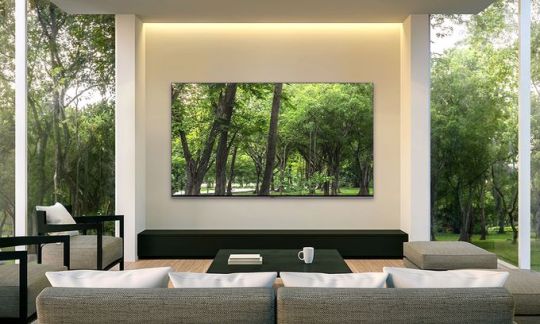
For decades, competition stimulates innovative boom in the consumer electronics segment, including high-tech TVs. HDR technology, HDMI 2.1 standard, 10 and 12-bit color depth, HFR (high frame rate) format, Micro LED, etc perfectly illustrate this trend.
Increasing the resolution of TV matrices is one of the main directions. Today, Samsung rightly claims to be the leader in this segment.
As known, in 2018, at the Samsung Forum, the company first introduced a series QLED 8K Q900R, including the QN65Q900RBFXZA, QN75Q900RBFXZA, QN82Q900RBFXZA, QN85Q900RBFXZA, and QN98Q900RBFXZA.

In 2019, Samsung expanded the series by announcing at IFA 2019 a new 55-inch QN55Q900RBFXZA QLED 8K model.
Of course, some experts were skeptical of the 8K resolution for 55-inch TV. As known, engineers increase the screen resolution precisely to improve the quality of large images. For example, for TVs up to 50 inches most people are unlikely to feel the difference between HD and 4K resolution. But the relatively low price of just over $ 2,000 substantially reduces the significance of this argument. However, the cost of the rest of Samsung's 8K TV has also decreased. In the fall of 2019, it does not exceed $ 3,000, $ 5,000, and $ 6,000 for 65-inch, 75-inch, and 82-inch, respectively. For comparison, the 85-inch Sony XBR-85Z9G costs about $ 13,000. Today the 75-inch Samsung QN75Q900RBFXZA competes with 75-inch LG Nanocell 75SM9970 (75SM9900 in Europe) 8K, which also costs about $ 5,000.
But, of course, the comparing the even 82-inch Samsung QN82Q900RBFXZA for $ 6,000 with LG OLED 88 Z9 8K with a price of $ 30,000 is unlikely to be correct.
Samsung QN75Q900RBFXZA vs LG Nanocell 75SM9970
The competition between these two giants has been going on for many years. Their 8K models use different matrices. In particular, Samsung 8K uses VA (Vertical Alignment) panels, LG Nanocell has IPS (In-Plane Switching) LCD panel. Basically, IPS-matrix vs VA-matrix differs in black level and viewing angle. As known, IPS panels provide a very wide viewing angle, but only an average level of black and contrast. VA panels provide excellent black level and contrast, but a small viewing angle. But according to the company, it managed to dramatically expand the viewing angle in the Q900R series.
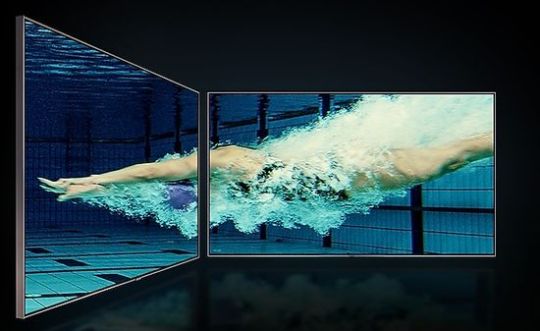
Today, LG produces OLED and Nanocell TVs. But LG's Nanocell technology is almost the same as Samsung's QLED technology. According to many experts, it was the company's marketing decision, because at that time Samsung had already patented QLED technology.
In turn, operating principle of VA and IPS panels is radically different from OLED matrices. In particular, OLED matrices provide absolutely black (infinite contrast) with relatively low brightness from 500 to 1000 nits in top models. LED models are inferior in terms of black level, but significantly win in brightness (up to 1,500 nits), providing a fairly high contrast.
Today, most experts note their features, including, for example, a sharper display of light areas and a magnificent Game mode with Input Lag only 15.4 ms for Samsung (for comparison, Input Lag of LG Nanocell 75SM9970 in Game mode reaches 43.6 ms). But in general, few of them give explicit preferences to any model. Therefore, the choice substantially depends on additional factors such as warranty, terms of delivery, etc or individual preferences (for example, design, browser, audio, etc).
Key Features
Models of Q900R series use the popular innovative Ambient Mode. In this mode, the TV displays a screen saver, for example, with a photo or picture.
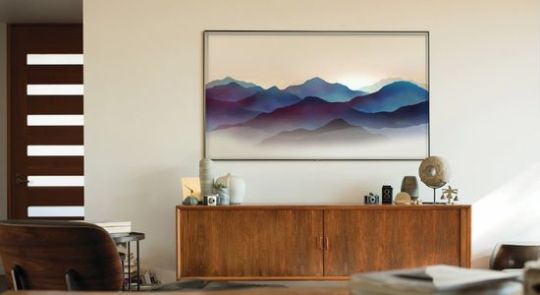
Moreover, a smartphone can provide a background image. This option requires only a photo of the TV on the wall through the app on the smartphone.

Ambient Mode uses a motion sensor that turns off the screen in an empty room. In turn, the light sensor adjusts the display brightness, providing the desired brightness regardless of the ambient light.
Additionally, the TV automatically activates the "Game Mode" in the case of connecting the console. In this mode, the Input Lag is reduced to 15.4 ms, compared to 112 ms in normal mode. Moreover, the TV optimizes color display settings and contrast.
Intelligent Mode automatically adjusts the picture brightness according to the ambient light.
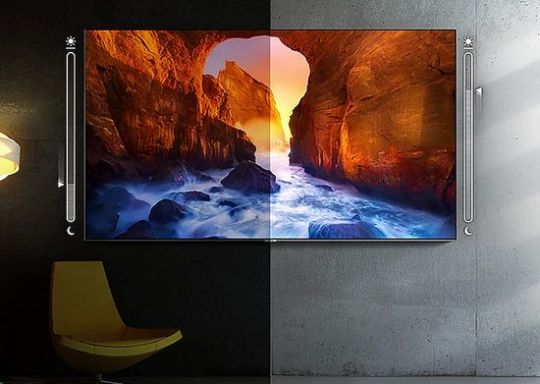
Quantum HDR 24X provides intensely deep colors and super-fine details with high clarity.
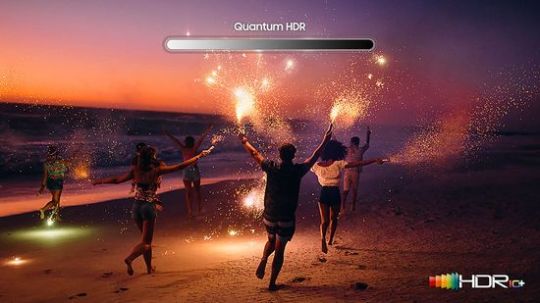
Quantum Processor 8K provides high-quality 8K AI Upscaling.
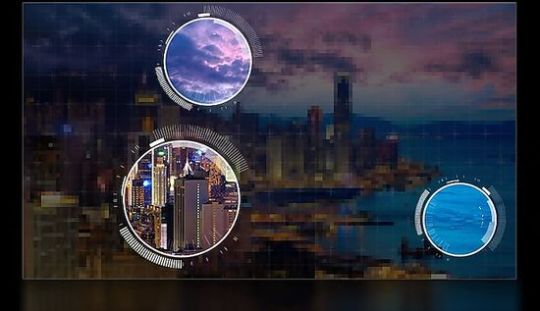
Samsung QLED 8K TVs support 100% Color Volume in the DCI-P3 color space and use FALD (Full Array Local Dimming).
All models support HDR10, HDR10+, and HLG standards.
Conclusion
Pros
- exellent image quality;
- 8k resolution;
- a significant reduction in prices;
- High Refresh Rate;
- high-quality 8K AI Upscaling;
- exellent Game Mode with only 15.4 ms;
- Ambient Mode;
- very wide viewing angles for a VA panel;
- 8K FPS via HDMI;
- Bluetooth Audio Playback;
- great local dimming and dark room performance.
Cons
- very limited 8K content;
- no 3D;
- "dirty" screen artifacts;
- do not support Dolby Vision and Dolby Atmos;
- no Advanced HDR by Technicolor;
- no IMAX Enhanced;
- do not support AMD Freesync;
- no 4K HFR and 2K HFR;
Of course, the appropriateness of buying expensive innovative models is always a dubious choice for many consumers. On the one hand, over the next few years, the processors of 8K models will mainly scale Full HD and 4K formats to 8K due to a shortage of 8K content. However, some factors in the 8K-TV segment are encouraging.
On the other hand, 8K TVs are already available to many fans of innovative devices with a good budget. But fierce competition could well contribute to lower prices in this segment in the near future.
A significant price reduction and a wide range of models (6 vs 2 models) allowed Samsung to get ahead of its traditional competitor LG.
This video offers review of the latest 55-inch Samsung 8K QLED TV.
Read the full article
#8KAIUpscaling#AmbientMode#LGNanocell75SM9900#LGNanocell75SM9970#QuantumProcessor8K#Samsung8KTVs#SamsungQ900R#SamsungQN55Q900RBFXZA#SamsungQN65Q900RBFXZA#SamsungQN75Q900RBFXZA#SamsungQN82Q900RBFXZA#SamsungQN85Q900RBFXZA#SamsungQN98Q900RBFXZA
0 notes